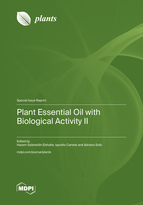Plant Essential Oil with Biological Activity II
A special issue of Plants (ISSN 2223-7747). This special issue belongs to the section "Phytochemistry".
Deadline for manuscript submissions: closed (20 February 2023) | Viewed by 35884
Special Issue Editors
Interests: natural products; microbiology; plant pathology; antimicrobial activities; bioactive secondary metabolites
Special Issues, Collections and Topics in MDPI journals
Interests: plant disease; natural products; molecular diagnosis; bioactive substances; microbiology; biological control
Special Issues, Collections and Topics in MDPI journals
Interests: agricultural and environmental chemistry; environmental botany; soil ecology
Special Issues, Collections and Topics in MDPI journals
Special Issue Information
Dear Colleagues,
The journal and MDPI (the pioneer in scholarly open access publishing) will publish a Special Issue on “Plant Essential Oil with Biological Activity”. Plant essential oils (PEOs), extracted from many aromatic and medicinal plants, have been used in folk medicine and often represent an important part of the traditional pharmacopoeia: they have a long history of use, in folk medicine, as antimicrobial agents, to control several human and phyto-pathogens. In recent decades, research in this field has gained great momentum, especially from research/medical institutions and pharmaceutical companies: many PEOs have been registered as effective alternatives to chemical and synthetic antimicrobials as well as have been used effectively in the food industry as antioxidants and anticarcinogens. The current Special Issue discusses the chemical composition and biological-pharmaceutical activities of some important PEOs and their single constituents. Detailed information regarding the mechanisms, possible mode of actions, and factors affecting these activities, such as geographical origins, environmental conditions, nutritional status, and extraction methods, are of great interest.
Prof. Dr. Hazem Salaheldin Elshafie
Prof. Dr. Ippolito Camele
Prof. Dr. Adriano Sofo
Guest Editors
Manuscript Submission Information
Manuscripts should be submitted online at www.mdpi.com by registering and logging in to this website. Once you are registered, click here to go to the submission form. Manuscripts can be submitted until the deadline. All submissions that pass pre-check are peer-reviewed. Accepted papers will be published continuously in the journal (as soon as accepted) and will be listed together on the special issue website. Research articles, review articles as well as short communications are invited. For planned papers, a title and short abstract (about 100 words) can be sent to the Editorial Office for announcement on this website.
Submitted manuscripts should not have been published previously, nor be under consideration for publication elsewhere (except conference proceedings papers). All manuscripts are thoroughly refereed through a single-blind peer-review process. A guide for authors and other relevant information for submission of manuscripts is available on the Instructions for Authors page. Plants is an international peer-reviewed open access semimonthly journal published by MDPI.
Please visit the Instructions for Authors page before submitting a manuscript. The Article Processing Charge (APC) for publication in this open access journal is 2700 CHF (Swiss Francs). Submitted papers should be well formatted and use good English. Authors may use MDPI's English editing service prior to publication or during author revisions.
Keywords
- essential oils
- antimicrobial activity
- cytotoxicity
- phytotoxicity
- antioxidant
- phytopathogens
Related Special Issues
- Plant Essential Oil with Biological Activity III in Plants (4 articles)
- Plant Essential Oil with Biological Activity in Plants (16 articles)









